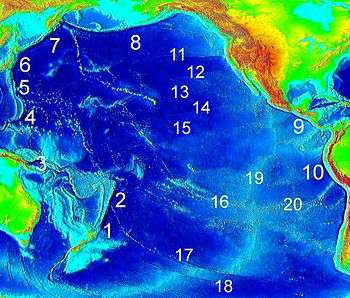Clipperton Fracture Zone

The Clipperton Fracture Zone is a geological submarine fracture zone of the Pacific Ocean, with a length of some 4500 miles (7240 km).[1] It is one of the five major lineations of the northern Pacific floor, south of the Clarion Fracture Zone, discovered by the Scripps Institution of Oceanography in 1950. The fracture, an unusually mountainous topographical feature, begins east-northeast of the Line Islands and ends in the Middle America Trench off the coast of Central America.[1][2][3] It roughly forms a line on the same latitude as Kiribati and Clipperton Island. The fracture can be divided into four distinct parts:
- The first, 127°–113° W, is a broad, low welt of some 900 miles, with a central trough 10 to 30 miles wide;
- the second, 113°-107° W, is a volcano enriched ridge, 60 miles wide and 330 miles long;
- the third, 107°-101° W, is a low welt with a central trough 1,200–2,400 feet deep which transects the Albatross Plateau; and
- the fourth, 101°-96° W, contains the Tehuantepec Ridge which extends 400 miles northeast to the continental margin.[3]
The Nova-Canton Trough is often seen as an extension of the fracture.[4]
In 2016, the seafloor in the Clipperton Fracture Zone – an area being targeted for deep-sea mining – was found to contain an abundance and diversity of life, with more than half of the species collected being new to science.[5]
References
- 1 2 "Clipperton Fracture Zone". Encyclopædia Britannica. Retrieved 17 November 2011.
- ↑ Keating, Barbara H. (1987). Seamounts, islands, and atolls. American Geophysical Union. p. 156. ISBN 978-0-87590-068-1. Retrieved 17 November 2011.
- 1 2 H. W. Menard and Robert L. Fisher (1958). "Clipperton Fracture in the Northeastern Equatorial Pacific". The Journal of Geology. 66 (3): 239–253. Bibcode:1958JG.....66..239M. doi:10.1086/626502. JSTOR 30080925.
- ↑ Contributions – Scripps Institution of Oceanography. Scripps Institution of Oceanography. 1972. p. 69. Retrieved 17 November 2011.
- ↑ "Abundant and diverse ecosystem found in area targeted for deep-sea mining". EurekAlert. 29 July 2016. Retrieved 31 July 2016.